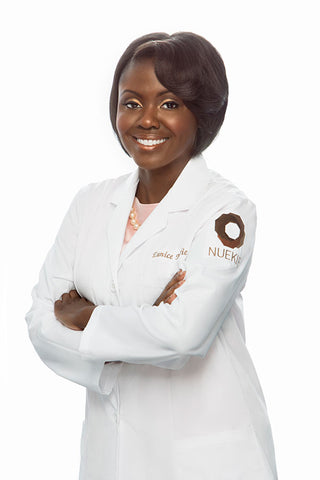 What Does Acne Look Like?
What Does Acne Look Like?
Acne is a term that we speak of broadly, however, there are a variety of skin ailments that fall under the category of acne.
Everyone is affected differently by acne and when you’re trying to treat yours, it’s important for you to be able to recognize and diagnose the type of acne you’re dealing with. This is especially important because you could actually be dealing with more than one type of acne, so that makes it even more essential to understand how to treat your skin.
There are a variety of different types of acne lesions: blackheads, whiteheads, papules, pustules, and cysts.
Let’s take a look at a definition of each acne lesion type.
And, with the scientific terms we shared from our last article, you can start seeing how and where these lesions originate.
Blackheads—these are plugs of sebum that clog a hair follicle. They become dark due to oxidation.
Whiteheads—when follicles become plugged and covered by a thin layer of skin that look like white bumps or spots.
Papules—these are inflamed lesions that may look red and are often sensitive and can be painful.
Pustules—while similar to papules, in that they are inflamed lesions, these usually are pus-filled and may appear white or yellow.
Cysts—this is a severe type of acne lesion. Cysts are inflamed, filled with pus and are generally painful.
Now, while there are specific types of acne lesions, acne is generally categorized into three main overarching types:
- • Non-inflamed acne
- • Inflamed acne (or inflammatory acne)
- • Combination acne (non-inflamed and inflamed acne)
While these are the primary categories of acne, there are actually many different types of acne, however, for this article, we’ll focus on looking at these main categories.
Non-Inflamed Acne
This type of acne is characterized by skin that is congested and has blackheads and closed comedones. Those dealing with non-inflamed acne have very few actual pimples and those pimples rarely become inflamed.
Characteristics of Non-Inflamed Acne:
- - Skin has a dull appearance
- - Skin looks congested
- - Blackheads might be visible
- - Few or no inflamed pimples present
- - Skin is usually not sensitive or reactive to products
Inflamed Acne
This type of acne is characterized by mostly inflamed lesions that are generally quite sensitive. Inflamed acne is a result of P. Acnes bacteria infecting the pore and causing an infection. Pustules and cysts fall under the category of inflamed acne.
Characteristics of Inflamed Acne
- - Redness is visible
- - Lesions feel hot or warm to the touch
- - Pimples, pustules, and inflamed lesions are inflamed with very few non-inflamed lesions
- - Skin tends to be sensitive and reactive to products
- - Could have cystic acne
Combination Acne
Evident in the name, this type of acne is a combination of non-inflamed acne and inflamed acne. In the case of combination acne, closed comedones under the skin can become easily inflamed and turn into inflamed lesions.
Characteristics of Combination Acne
- - May have some visible redness /warm to touch
- - Pimples, pustules, blackheads, and closed comedones may be visible
- - May have cysts
- - Skin can be sensitive and reactive to products
Now that we have a better understanding of what the different types of acne lesions look like, we can now begin treating acne accordingly, based upon the specific characteristics that appear. In our next article, you will learn about the various types of therapies that treat acne.

